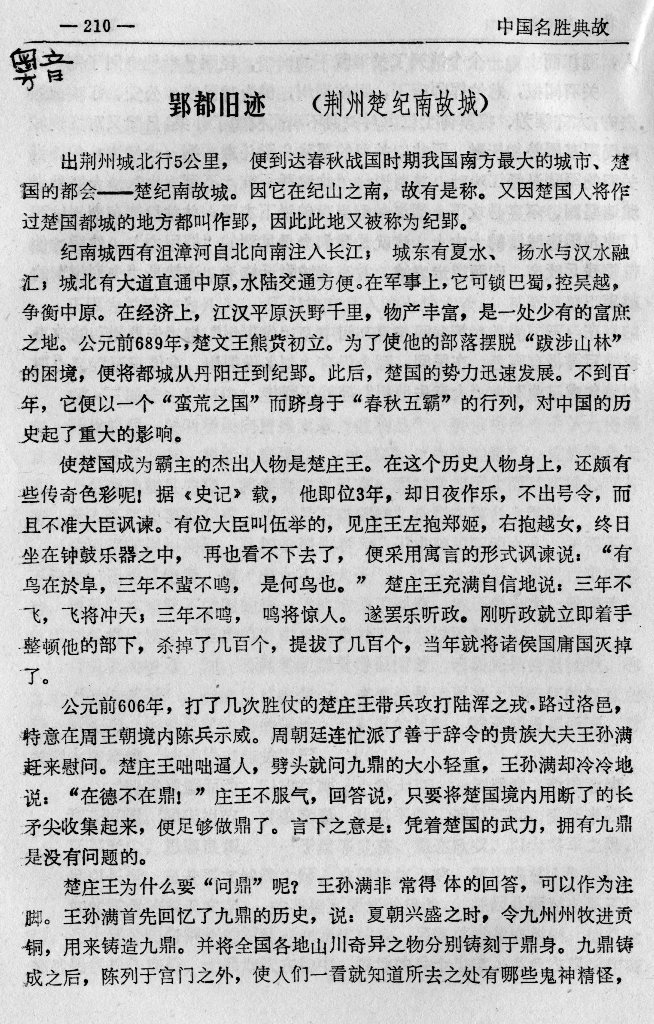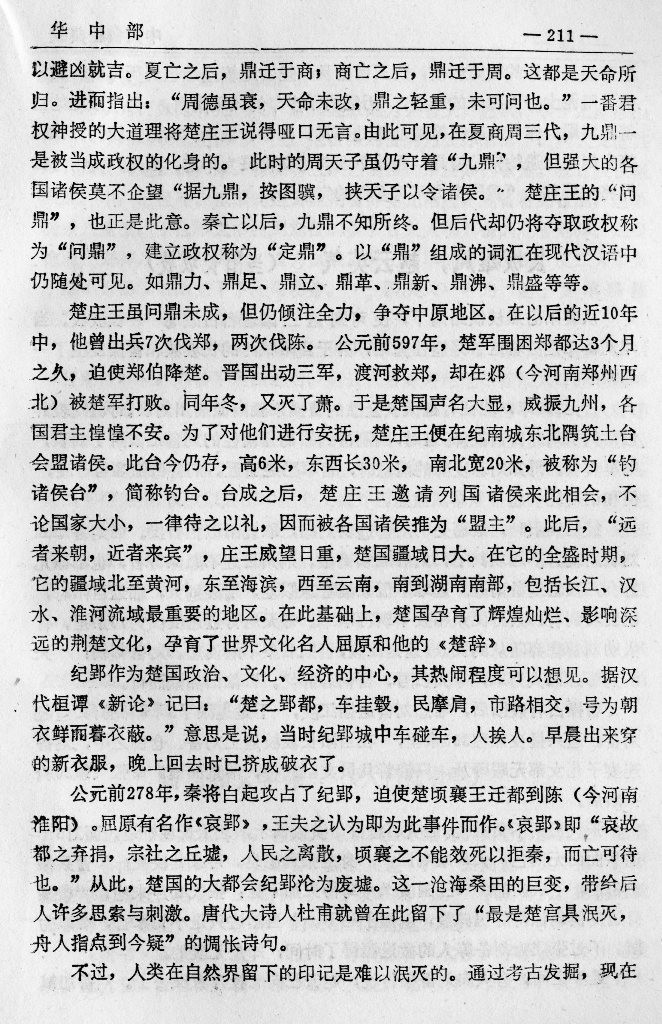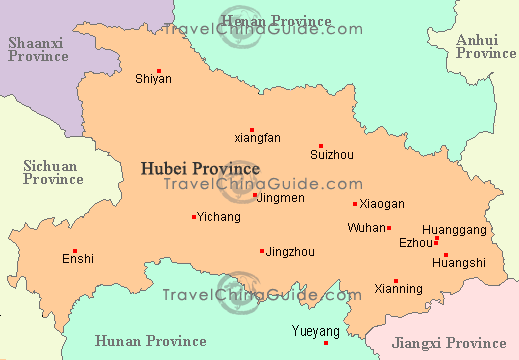| Author | Message | ||
Ld Username: Ld Registered: 01-2007 |
   | ||
Ld Username: Ld Registered: 01-2007 |
Images from the history http://www.hp.uab.edu/image_archive/index.html Kingdom of Chu http://www.hp.uab.edu/image_archive/uac/index.html 1. A map of Jing-Chu on the Yangzi River. The region in the second millenium B.C. had been periodically subject to the Shang, but in the Zhou period it rose from modest beginnings to become a powerful independent kingdom. Era of Shang hegemony (2nd millenium B.C.) Bronze bells 1. Jia bronze from Panlongcheng, Huangpi Xian, Hubei, near north bank of the Yangzi. It is from the Erligang (early Shang) period. Although a local product, the style and technology reflect the influence of the Shang bronze tradition, introduced by Shang aristocratic immigrants. 30.1 cm. h. Fang Zun from Huangcai 2. Fang zun bronze from Huangcai, Ningxiang Xian, Hunan. 58.3 cm. h. By the late Shang era, the Chu region was beginning to develop its own bronze style, with pieces that are larger and more elegantly caste than the Shang bronzes of the Central Plain to the North. Jue from Xiangxiang Xian 3. Late Shang era jue bronze from Xiangxiang Xian, Hunan. 33 cm. h. This also illustrates the monumental size and refined casting of Chu bronzes. Many bronzes classified as Shang are now recognized to be Chu bronzes. You from Shimen, Hunan, Chu 4. You discovered in 1956 in Shimen, Hunan. 47. 5 cm. h. Chu bronzes had distinctive decoration: Taotsi masks with broad crest linked with the nose; bird flanges on sides, and fish motifs on the feet. This bronze has all these features and is entirely different from the Shang bronzes to the north. http://www.travelchinaguide.com/cityguides/hubei/xiangfan/ Bronze drum from Chongyang, Hubei, Kingdom of Chu 6. Bronze drum from Chongyang, Hubei. 75.5 cm. h. Based on its features, a Chu product. Just as the Chu bronze tradition emerged from that of the Shang, so too, other regions in the South and West in turn acquired a bronze tradition from the Chu. Chu Kingdom (c. 1100-223 B.C.) Chu Wang Yinshen zhan bronze, Kingdom of Chu, under Xiongui 1. When Chu became an independent state under Xiongyi, it entered cultural decline. Apparently the ethnogenesis that had driven the earlier Jing-Chu cultural vitality ended with the Shang. But by the sixth century, local traditions reasserted themselves in terms of cultural forms quite different from that of the Shang. Here a Chu Wang Yinshen zhan bronze with a dense finely coiled serpent decoration. 20 cm. h. Jin from Xiasi, Sichuan Xian, Henan, Kingdom of Chu 2. Jin from Xiasi, Sichuan Xian, Henan. 107 cm. l. These Xiasi bronzes of the mid-Spring and Autumn Period (6th c. B.C.) tend to employ the new lost wax method of casting, which then spread north to the Zhou regions. Yongzhong ritual bells, in Zhou tradition, Kingdom of Chu 3. Set of six bronze ritual yongzhong bells, 6th c. Sackler Gallery, Smithsonian, Washington D.C. US. s87.0004.0009. Chime bells and lithophones characterize the ritual orchestra associated with the Chu court, which reflects Zhou tradition. Lithophone from tomb of Zeng Hou Yi, Kingdom of Chu 4. A lithophone of 32 chime stones from the tomb of Zeng Hou Yi. By the Warring states Period, there is Chu evidence of a shift in emphasis to music for entertainment - a major break in Chinese musical history. Bird from tom of Zeng Hou Yi, Leigudun, Suizhou, Hubei, Kingdom of Chu 5. Antlered bird from tomb of Zeng Hou Yi, Leigudun, Suizhou, Hubei. 143.5 cm. h. Such a bronze adaptation of wood carving, of symbolic significance, extended beyond the Chu culture sphere. Like ritual drums that were more symbolic than functional, it reflects a cultural influence from the south. State of Shu (Sichuan) Shang bronze from Sanxingdui, Guanghan Xian, Sichuan, Shu 1. Shang era bronze zun from Sanxingdui, Guanghan Xian (just north of Chengdu), Sichuan. 53 cm. h. From a Shu State sacrificial pit. This piece, with its seated birds on its shoulders and high swollen footring, reflect Chu bronze traditions rather than the Shang.  【1】Jia bronze from Panlongcheng, Huangpi Xian,  【2】Late Shang era jue bronze from Xiangxiang Xian,  【3】Set of six bronze ritual yongzhong bells,  【4】Fang Zun from Huangcai 2. Fang zun  【5】You discovered in 1956 in Shimen, Hunan.  【6】Yue (war axe) found in Hunan in 1971  【7】Bronze drum from Chongyang,  【8】State of Shu (Sichuan)  【9】  【10】Jin from Xiasi, Sichuan Xian, Henan.  【11】Antlered bird from tomb of Zeng Hou Yi,  【12】  【13】  【14】  【15】  【16】  【17】  【18】  【19】A lithophone of 32 chime stones from the tomb of Zeng Hou Yi.  【20】 ============================================ Bianzhong of Marquis Yi of Zeng he Bianzhong of Marquis Yi of Zeng (Chinese: 曾侯乙编钟; Pinyin: Zēnghóuyǐ Biānzhōng), or Zenghouyi Bells, were bianzhong unearthed in 1978 in the Zeng-hou-yi Tomb in Sui County, Hubei Province, China. The bianzhong were made in 433 B.C.. The bianzhong are hung on two sets of wood racks. One rack is 7.48 meters long X 2.65 meters wide. the other rack is 3.35 meters long X 2.73 meters wide. The two racks are perpendicular to each other. The bianzhong are constituted by altogether 65 bells, which are hung at three levels and are divided into eight groups. There are 19 bells in three groups at the top level. There 33 bells in three groups at the middle level. There are 12 bells in two groups at the bottom level. There is another big bell. The biggest bell is of 153.4 cm height and 203.6 kg weight. The smallest bell is of 20.4cm high and 2.4kg weight. Each bell in the Bells can play two tones with three degree's interval between them. The tonal range of Zenghouyi Bells is from C2 to D7. In the middle area of the tonal range, it can play all twelve half tones. The wood hammers used to strike the bells were unearthed from the Zeng-hou-yi Tomb as well. | ||
Ld Username: Ld Registered: 01-2007 |
  | ||
Ld Username: Ld Registered: 01-2007 |
香港大專社會服務隊(四十五周年) 三峽、荊楚文化之旅 重慶、長江三峽、宜昌、荊州、武漢(10天) 出團日期: 2009年10月11日(星期日)至18日(星期日) 人數: 約30人(其中約5人15/10離團) 行程: 第一天:11/10 (日) 香港~深圳~重慶 上午10:00於指定地點集合,乘直通巴往深圳機場,乘內陸機CZ3455(13:20/15:20)往重慶。 下午往涪陵區(約1小時車程),參觀[涪陵]白鶴梁題刻(石魚石刻),瞭解古代長江中游枯水位的石刻標誌方式,及1200餘年歷史枯水位情況與枯水規律。(涪陵白鶴梁石刻,有部分已經存放在三峽博物館,其餘部份目前正在修建水下博物館,預計5月1日開放。 餐:晚餐 宿:萬友康年(四星)或同級 第二天:12/10 (一) 重慶 上午參觀重慶中國三峽博物館,了解三峡水利枢纽工程涉及的1087处文物的保護情況,考古成果,三峡和重庆地区的历史文化和自然资源。 下午參觀磁器口古鎮、解放碑步行街。 晚餐後19:00登船,22:30遊船開航。 餐:早、午、晚(重慶鴛鴦火鍋風味)餐 宿:世紀之星遊船(五星) 第三天: 13/10(二) 長江三峽 上午行程及遊船設施說明會;文化活動暨講座; 14:00-17:00上岸參觀豐都雪玉洞,船長歡迎晚宴及歌舞表演。 餐:早、午、晚餐 宿:同上 第四天:14/10(三) 長江三峽 06:30-08:00上岸遊覽白帝城; 08:00-08:30船觀瞿塘峽風光; 09:00-13:00上岸遊覽巫山小三峽、小小三峽; 13:00-15:00船觀巫峽風光; 16:00-18:00船觀西陵峽風光(西段); 歡送晚宴;20:00-24:00通過三峽大壩船閘。 餐:早、午、晚餐 宿:同上 第五天: 15/10 (四) 長江三峽-宜昌 08:00-10:00上岸參觀三峽大壩,瞭解長江三峽水利樞紐工程的總體規劃、二期工程進展,及目前的運作情況。 10:00-11:00船觀西陵峽風光(東段); 11:30抵達宜昌下船,乘車前往參觀長江西陵峽鍊子岩,瞭解長江三峽中最大的地質災害隱患的治理,及中國最為先進的治理地質災害技術。乘車往牬歸新城,瞭解遷都城鎮的規劃建設情況,訪問一移民新村,瞭解國家對三峽工程移民的政策和安置情況。繼往宜昌。 【約5位團員離團,於宜昌乘內陸機ZH9944(10:30/11:55)或MU2483(1430/1750)往深圳,轉乘深圳機場香港快線直通巴返港】 餐:早、午、晚餐 宿:宜昌盈嘉大酒店(四星級)或同級 第六天:16/10(五) 宜昌~荊州 往荊州(約1.5小時車程),參觀荊州大堤、荊江分洪工程紀念碑亭、萬壽塔(明),瞭解新中國誕生後的第一個大型水利設施荊江分洪工程—分洪區圍堤和荊江北岸大堤加固等工程,及長江水患的治理情況。參觀荊州熊家塚墓地考古現場(春秋晚期至戰國中期),瞭解戰國時期高等級貴族的墓葬葬制、葬俗。參觀荊州城(明、清,世界文化遺產),瞭解古城的修築史, 建構設計,及古代戰爭的功能特點。 餐:早、午、晚 住:荊州金九龍(四星級)或同級 第七天:17/10(六) 荊州~鍾祥 上午往荊州博物館,參觀精工細作的青銅禮器、玉器,紋飾華麗、造型奇異的漆木器,巧奪天工的絲織品,瞭解江漢平原發展起來的楚人土著文化與中原及周邊民族文化相融合的過程,和楚文化形成的歷史。參觀荊州市文物考古研究所,瞭解文物保護及文物修覆情況。 下午往緟祥(約2小時車程)。參觀顯陵(明,世界文化遺產),瞭解中南地區明代帝陵中最大的單體陵墓“一陵兩塚”的陵寢結構。 餐:早、午、晚餐 宿:鍾祥莫愁湖國際大酒店(四星級)或同級 第八天:18/10(日) 鍾祥~襄樊 上午往襄樊(約2小時車程),參觀襄陽古城(漢)、襄阳护城河,瞭解“樓閣依山出,城高逼太空。”人稱“華夏第一城池”的襄陽城佈局。參觀米公祠,瞭解北宋書畫大師米芾( 創制“米氏雲山”)的繪畫藝術史。 下午參觀襄樊博物館,從原始社會到晚清時期的青銅器、陶器、玉器及車馬坑等971件珍貴文物,其中100多件為國家一級文物,較全面地了解襄樊2800多年的歷史文化。 餐:早、午、晚 住:襄樊維也納酒店(準5星)或同級 第九天:19/10(一) 襄樊~武漢 上午往武漢(約5小時車程)。 下午參觀湖北省博物館,目睹湖北省從原始時期以來各個歷史時期的社會制度、社會生產和社會生活的各類文物、標本,領略精美絕倫的青銅鑄造,浪漫璀璨的髹漆藝術,玲瓏剔透的琢玉工藝,感悟燦爛輝煌、獨樹一幟的荊楚文化。 餐:早、午、晚(楚宴) 住: 鑫湖盛京大酒店(準四星)或同級。 第十天:20/10(二) 武漢~深圳~香港 上午繼續參觀湖北省博物館(或自費門票參觀黃鶴樓、歸元寺,或自由活動)。 下午往機場,乘內陸機CZ3355(1500/1640)往深圳,轉乘直通巴往香港。 餐:早、午餐 參考價: 10天團費HK$10,150.00/人單人房差HK$3,320.00/人(含船上單人房差HK$2,010.00) 5天團費HK$6,820.00/人 單人房差HK$2,150.00/人(含船上單人房差HK$2,010.00) 團費包括: 1. 往返經濟客位機票、往返機場建設費(目前內陸航班無燃油附加費)。 2. 行程上所列明交通(直巴及內地旅遊巴)、船、餐食、參觀門票、住宿(2人1房)等費用。 3. 參觀機構之聯絡安排。 4. 專家現場介紹。 5. 國內導遊﹑司機小費。 6. 香港領隊。 7. 保險:藍十字旅遊寶中國基本。(香港旅遊業議會建議會員在旅行團出發前宜要求所有參加旅行團的旅客購買旅遊保險,範圍最少包括緊急撤離、傷殘及死亡賠償。為妥善照顧團員,同時使交流考察團更為順暢,團費中加入了有關保險。 團費不包括: 1. 個人消費,如洗熨﹑長途電話費等。 2. 臨時取消或更改行程﹑住宿﹑餐食及行程表以外之費用。 3. 簽證費。 4. 訪問交流用品。 註: 1. 報價及行程僅供參考,以將確定後的參觀內容、日期、機位等計實及調整。 2. 船及航班僅供參考,以船及航空公司確認訂位為準。 3. 長江沿岸的參觀點按世紀之星航程,會視季節及水位調整。 4. 行程可能因天氣、水位的關係和不可預知之因素而調整。 5. 不購物、不另收小費。 參考資料(可直接點入網頁): 三峽工程的背景資料 三峽文物的價值 三峽工程移民大事記 荊楚文化 荊楚文化的八大特點 ====================================== 報 名 表 姓名: (中文) (英文) 性別: 男□ 女□ 出生日期: 年 月 日 ID NO.: 回鄉證/護照NO.: 有效期: 年 月 日 聯絡電話  日間) (夜間) 日間) (夜間) 地址: E-mail: 報名線路: 香港大專社會服務隊(四十五周年) □三峽、荊楚文化之旅2009年10月11日(日)至18日(日) 10天 參考團費HK$10,150.00/人 單人房差HK$3,320.00/人 訂金HK$1,000.00/人 □三峽文化之旅2009年10月11日(日)至15日(四) 5天 參考團費HK$6,820.00/人 單人房差HK$2,150.00/人 訂金HK$1,000.00/人 單人房 □ 同行人: 其他要求: 付款辦法: 郵寄支票付款-支票抬頭: 香港青年中華文化交流中心有限公司 或 Hong Kong Youth Chinese Cultural Exchange Centre Ltd 寄往: 香港上環孖沙街12-18號金銀商業大廈7樓701-702室 將費用存入- 中國銀行"香港青年中華文化交流中心有限公司 或 Hong Kong Youth Chinese Cultural Exchange Centre Ltd. 012 676 101 17168" 并將入數紙傳真至31063960,會計部 | ||
Ld Username: Ld Registered: 01-2007 |
三峡工程移民大事记(1985年-2001年) http://www.china.com.cn/news/txt/2007-07/11/content_8505571_4.htm 三峽文物的價值 三峡文物十大价值 http://news.socang.com/dynamic/local/2004510/3975.shtml 背景资料:三峡工程三期围堰——右岸建设的屏障 http://news.qq.com/a/20060606/001311.htm |